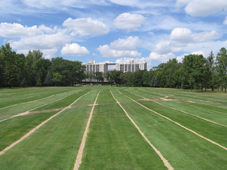Down the Tubes:
The Benefits of Subsurface Drainage
By John Van Roestel, Owner of TDS Turf Drainage Systems Ltd.
 How and why a subsurface drainage system works is sometimes difficult to explain and often hard to justify — until you see the results. A properly installed and maintained drainage system can effectively deal with both surface and subsurface drainage water. At the same time, it can save money by improving turf health and reducing maintenance costs, and can actually pay dividends by eliminating or reducing golf course closures due to rain.
How and why a subsurface drainage system works is sometimes difficult to explain and often hard to justify — until you see the results. A properly installed and maintained drainage system can effectively deal with both surface and subsurface drainage water. At the same time, it can save money by improving turf health and reducing maintenance costs, and can actually pay dividends by eliminating or reducing golf course closures due to rain.
Drainage 101
When soil is properly drained, a thin layer of capillary water is held onto soil particles, and air fills the remaining space. This combination of soil, air and water is the ideal environment for roots and beneficial organisms. Drains provide an escape route for excess water in soil. Healthier roots will survive any subsequent drought better, and many moisture-related diseases like Pythium root rot, Pythium blight, Rhizoctonia brown patch and other diseases will be avoided.
Other advantages to good drainage include:
- Greater soil load-bearing ability. Foot traffic from golfers as well as wheeled traffic from golf carts and mowing equipment will cause less compaction to well-drained soil. A good drainage system will promote better turf growth, and speed up play.
- Better water absorption after a rainfall, as well-drained soil has more air space. This reduces surface runoff and ponding in low-lying areas. In poorly drained soil, these spaces are waterlogged, and pooling and flooding are often the result.
- Improvement of subsoil moisture conditions. A subsurface drainage system lowers the water table for a considerable distance from the drain.
Before you start
When designing a drainage system, it is important to know the area in terms of the course’s watershed. A topographical survey will be needed to determine this. The resulting topographical map can cover hundreds or even thousands of acres depending on the golf course. (Figure 1 is a topographical map of just one green.) With this information, calculations can then be made on how much water will have to be dealt with.
A consideration often overlooked when designing a drainage system is pipe size. A 100-mm (4-in.) pipe may be sufficient for a drainage system on your fairway this year, but what about next year or the year after that? You may want to drain other fairways or drain a sand trap into the same pipe, which will then become suddenly undersized.
Collector drains
Collector drains are the foundation of any drainage system. They are usually the longest and the deepest drains on a golf course, 150 mm (6 in.) in diameter and .9 m (3 ft) deep. These main lines carry the drainage water collected by lateral drains to an outlet, which could be a pond, river or stream. They are normally installed in the lowest-lying part of the area to be drained and are sized according to how much water will be going into them and the percentage of slope on the drain. A drain with a one per cent slope will move more water then a drain with a .1 per cent slope.
The amount of water flowing into a collector depends on many variables. Some of the more obvious ones are the total area of land drained into the system and the type of drainage system—for instance, whether it is a slit drain system with sand backfill or one with native-soil backfill. Other variables include the amount of surface inlets and catch basins.
By themselves, collectors can have a huge impact on an area. When installed with properly designed and situated catch basins, excess rainwater can be handled with ease. While collectors can often get rid of the bulk of the water on their own, more often than not, they are usually the first phase of a two-phase drainage system project.
There are two main types of drainage systems, and either or both can be used on the same course:
Lateral drainage systems
The lateral drainage method involves digging a trench .6 m (2 ft) deep and placing a perforated 100-mm (4 in.) diameter pipe in it, which is then backfilled with native soil. Results will vary with this system depending on the type of soil. Sandy soils, for example, will drain faster than clay soils. The conventional method of well-placed surface inlets is usually effective in sandy soil because excess water moves very well through the soil particles.
While this conventional system is often adequate, with the demands on golf courses today, superintendents need to get players out on the green right after a rain—and fast! A slit-drainage system allows for this.
Slit drainage systems
 With this technique, a special wheel trencher digs a .3-m (1-ft) trench and conveys the native soil into a trailer running alongside. Simultaneously, the machine places a 50-mm (2-in.) diameter pipe into the trench through a chute attached to the wheel. In a second step, the trench is backfilled to the surface with sand or small stones. Often, both steps are combined into one smooth operation. The trencher is equipped with a state-of-the-art laser-control system that automatically tracks and makes corrections to keep the drain lines at the designed slope and depth, an important factor where the undulating terrain of a golf course is concerned.
With this technique, a special wheel trencher digs a .3-m (1-ft) trench and conveys the native soil into a trailer running alongside. Simultaneously, the machine places a 50-mm (2-in.) diameter pipe into the trench through a chute attached to the wheel. In a second step, the trench is backfilled to the surface with sand or small stones. Often, both steps are combined into one smooth operation. The trencher is equipped with a state-of-the-art laser-control system that automatically tracks and makes corrections to keep the drain lines at the designed slope and depth, an important factor where the undulating terrain of a golf course is concerned.
A sand or sand/stone mixture is used for fast removal of surface water. It is important to let the turf establish itself in the narrow sand trench rather than lay sod over the trench line. By establishing the turf in the sand, drainage performance is not affected as the water will move through the sand much faster then it would through layered sod. A filter-wrapped pipe is recommended when using sand, to avoid clogging, but not recommended with stone backfill.
When designing a slit drainage system, it is important to design the drains so they run across the ground perpendicular to the direction the excess water would run, and with a positive slope (.5 per cent is often used as a minimum). The importance of a good topographical survey cannot be emphasized enough at this point. The slit trenches are installed at an average spacing of 1.5 m (5 ft) and serve to collect the excess water as it runs across the ground surface, channeling the water to the collectors and then to an outlet.
Problems and solutions
Side hill seepage is a drainage problem that most golf courses seem to have but can be remedied with a well-placed drain. Quite often the water is running along the top of a harder layer of soil or rock and will seep out when it reaches a more permeable area, usually the side of a hill or another soil type. The location and depth of the drain is critical to intercept the water causing the drainage problems.
Proper installation techniques and equipment will avoid silting in backgrades, and careful backfilling techniques will reduce damage from rocks. A good outlet is important: Well constructed, it will serve the drainage system for years. Animal guards are recommended to prevent muskrats and other animals from entering the system and causing a blockage. They have a hinged grate on the end of the outlet to allow any debris in the system to escape.
The installation of slit drainage systems on older greens is fast becoming a viable option for groundskeepers, and can save a green from having to be totally rebuilt. The main candidates for this system are old push-up-style greens, which were built with little or no subsurface drainage and consist of heavier surrounding native topsoil. Through the years, they have become compacted and have developed impervious layers, causing excess water to remain on the surface and saturate the top of the root zone. With a good drainage system, excess water is allowed to escape before it can freeze and cause damage to the surface. With the water removed, sunlight can warm the green faster, giving it a jump start for the new season.
Other problems an older green may have are high areas that drain very well and low areas that do not drain well at all. When the high areas require watering, the low areas get over-watered. Superintendents usually resort to hand watering in these situations. A slit drainage system lets the superintendent apply the right amount of water to the high areas, while getting rid of the excess water in the poorly draining ones.
Payback time
It is easy to figure out the cost of a drainage system in terms of material and labour, but it is sometimes harder to calculate the payback. Here are some tangible considerations to help justify such a project:
- One or two wet spots, a waterlogged green or a fairway that stays wet after heavy rains can slow play or even call for course shutdown for a day or more. An extra day or two of green fees plus cart rentals can more than pay for the cost of a drainage project.
- A well-drained golf course can open earlier in the spring and can stay open later in the fall. Also, in the spring, much of the sun’s warmth is used to evaporate excess water from undrained soil, and this causes cooling. Well-drained soil is warmer in spring and thus provides for better growing conditions.
- Major reconstruction of older greens can be avoided by a properly designed slit-trench system.
Properly installed, a drain will work 24 hours a day, seven days a week, and is virtually maintenance free. A drainage system is truly an investment that will repay you many times over.

